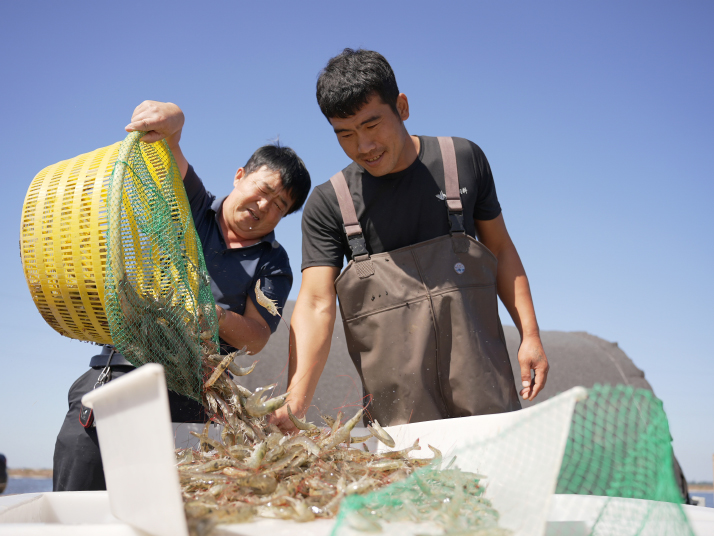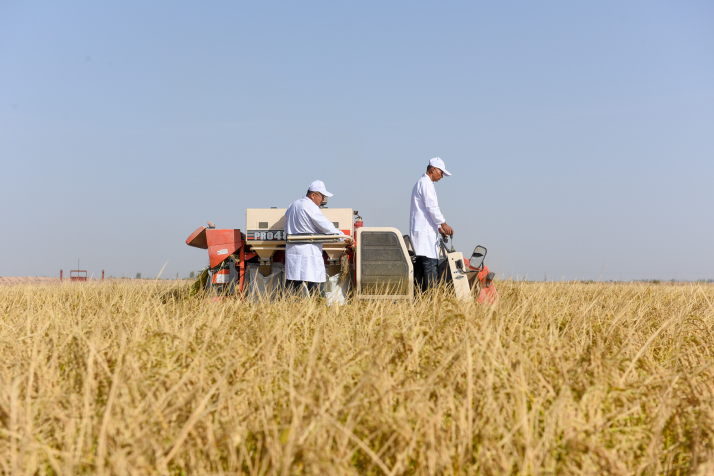| China |
| Efforts to transform saline-alkaline land in China are taking effect | |
|
|
 Farmers work at a shrimp pond on saline-alkaline tidal flats in Caijiazhuang Village, Cangzhou City of Hebei Province, on September 13 (XINHUA)
When traveling in Xinjiang Uygur Autonomous Region in northwest China, you might sometimes see vast fields of white, even though the winter snow has not yet come. These fields are saline-alkaline lands, where crops and other plants are almost totally unable to grow. Xinjiang's climate is arid and the annual rate of evaporation in the region can be more than 10 times the annual rainfall. Evaporation draws water, which contains dissolved salts and other chemicals, from deeper in the soil to the soil surface and, without sufficient rainfall to wash these salts back down, the salinity and alkalinity of the soil's surface layer continue to increase. Xinjiang has more saline-alkaline lands than any other provincial-level region in China, accounting for 36.8 percent of the nation's total. Today, science is turning these once barren lands into fertile farmland capable of producing reliable crops. Hu Shuwen, a professor of resources and environmental sciences at China Agricultural University, is one of the researchers making this miracle happen. His research team began experiments growing corn in saline-alkaline fields using drip irrigation and self-developed biological soil amendments in Hotan City of Xinjiang in July this year. The experimental technique increased the yield of corn grown on the saline-alkaline lands, harvested in late September, by 60 percent to around 45,000 kg per hectare, with the variety of corn grown, and the amount of fertilizer and water used remaining unchanged. According to the United Nations Food and Agriculture Organization (FAO), China now has around 100 million hectares of saline-alkaline lands, one third of which could be improved to increase productivity. "The transformation of these lands would improve the ecological environment and provide people with access to higher-quality agricultural products. It will expand the area of arable land and further ensure China's food security," Hu told Beijing Review. Overcoming bottlenecks Hu began research on the reclamation of salt-affected lands in 2008. He said saline-alkaline soils have low nutrient content and a sticky structure, which leads to slow water infiltration and less efficient desalting. The reclamation techniques include reducing salt in the top layer of soil physically, applying amendments to desalt soil, and using salt-tolerant crops. Hu has established a 12-member team focusing on reclamation research. The team has established over 130 experimental stations nationwide and the fields are their laboratories for around seven months each year. To date, they have collected over 32,000 soil samples and reclaimed over 126,700 hectares of saline-alkaline lands. Of these, 6,000 hectares were undeveloped lands with high salinity and alkalinity, and more than 100,000 hectares were saline-alkaline lands with low output. Their efforts have increased annual combined output of the lands by 200 million kg. Hu often compares the salts and other chemicals in the soil to flour, and the amendments they develop are aimed at making these substances form clumps to improve water permeability and desalinate the soil. "The reclamation of saline-alkaline lands through amendments is complicated. The technique needs to be adjusted based on factors including soil structure, salinity, crop variety, growing methods and irrigation," he said. According to Hu, there are multiple causes of salt-affected soil across China. Saline-alkaline lands in regions including Xinjiang and northeast China are mainly caused by dry climate. In coastal areas like Jiangsu and Shandong provinces, seawater is a major cause. While it has made strong progress in Xinjiang, Hu's team has focused on reclaiming saline-alkaline lands in northeast China, especially Jilin Province where around 960,000 hectares are affected. Over the past decade, high-salinity barren lands in the province have become rice fields with the output per hectare exceeding 7,500 kg through the efforts of the team. Before that, crop failure was common in local rice fields. Chinese restoration practices are now going global. In June this year, Hu gave presentations at the headquarters of the FAO in Rome, Italy, introducing the desalination techniques to counterparts from Egypt and Central Asian countries. As he introduced, Egypt, which has a similar natural environment to Xinjiang, has adopted the drip irrigation methods developed by his team. "We'll launch the land restoration techniques in more countries next year," he said.  Researchers harvest rice in a demonstration field in Aral City, Xinjiang Uygur Autonomous Region, on October 13 (XINHUA)
Turning waste into wealth In Xinjiang, where water resources are precious, the use of salt-tolerant crops plays a role not only in increasing the output of saline-alkaline lands but in absorbing salt from the soil and gradually decreasing salinity. "Previously, we had to use around 30,000 cubic meters of water for restoring 1 hectare of saline-alkaline land. This practice is unsustainable given the shortage of water in Xinjiang," Tian Changyan, a researcher at the Xinjiang Institute of Ecology and Geography of the Chinese Academy of Sciences, told Xinhua News Agency. In 2000, Tian's team chose several varieties from a list of 300 salt-tolerant plants and planted them in Xinjiang. According to Tian, some plants were capable of removing 85 percent of the salt from soils after three years of growing. The amount of water needed is 4,500 cubic meters per hectare a year. In addition to promoting naturally salt-tolerant plants, Chinese agricultural experts are improving the salt resistance and output of other crops through both traditional breeding practices and gene editing. Yuan Longping, the late academician known as the "father of hybrid rice," was a major contributor to the research and promotion of "seawater rice" in China. This new type of salt and alkali-resistant rice is designed to grow in tidal flats or other areas with heavy salt content. As Yuan once said, seawater rice can be grown on around 13 million hectare of saline lands in China. If every hectare produces 4,500 kg of rice, the fields will be enough to feed another 200 million people. In recent years, the growing of seawater rice has been promoted in Xinjiang, significantly increasing yields in recent years. Salt and alkali-resistant rice is now grown in a demonstration area of almost 700 hectares in Xinjiang's Aral City, with harvest reaching a record high of 8,607 kg per hectare this year. Xinjiang Zhongnong Haidao Biotechnology Co. Ltd., headquartered in Shenzhen, Guangdong Province, began growing seawater rice experimentally in Kashgar, Xinjiang, in 2018. The yield of rice per hectare has increased in recent years from 4,500 kg to over 7,500 kg. As local farmers learn to grow seawater rice, the per-household annual income has increased by 48,000 yuan ($6,560). Chinese seawater rice has been promoted for use in overseas regions including Dubai, the United Arab Emirates, since 2018. The output of seawater rice grown in the desert areas has reached 9,000 kg per hectare through drip irrigation and big data solutions for adjusting temperature and use of fertilizers. New industries are emerging to diversify the utilization of saline-alkaline lands in China. Many regions have transformed these lands for use in aquaculture. Additionally, in Ningxia Hui Autonomous Region and Shandong, salt-tolerant plants are grown to feed cattle and a vast wetland of red salt-tolerant plants in Panjin, Liaoning Province in northeast China, has become a popular travel destination. A priority The restoration and utilization of saline-alkaline lands have been major focuses of China's agricultural development in recent years. In May this year, the Central Government established the National Technical Innovation Center for Comprehensive Utilization of Saline-Alkaline Land in Shandong, which has pooled experts from research institutes across China. The research center will develop technologies to improve soils and achieve efficient use of water by 2025, and make breakthroughs on core technologies to make use of alkaline soils and develop tech enterprises in the sector by 2030. After 2030, the center will aim to find sustainable methods of applying the technologies and turn around 12.3 million hectares of China's alkaline soil into potential farmland, it said. (Print Edition Title: From Barrens to Barns) Copyedited by G.P. Wilson Comments to lixiaoyang@cicgamericas.com |
|
||||||||||||||||||||||||||||
|
